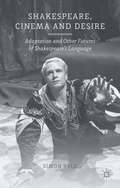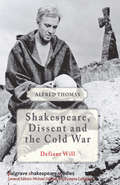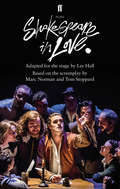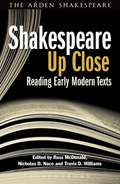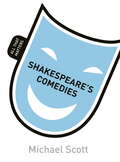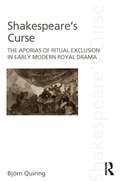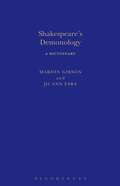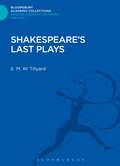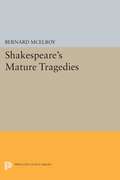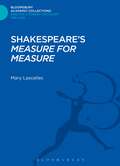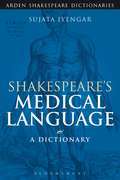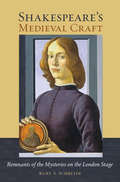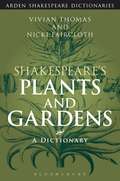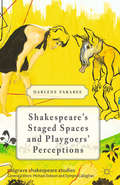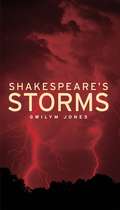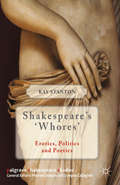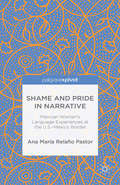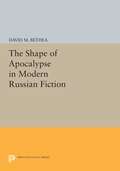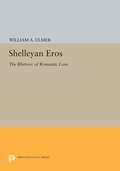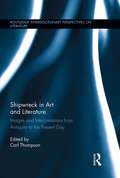- Table View
- List View
Shakespeare, Cinema and Desire: Adaptation and Other Futures of Shakespeare's Language
by S. RyleShakespeare, Cinema and Desire explores the desires and the futures of Shakespeare's language and cinematographic adaptations of Shakespeare. Tracing ways that film offers us a rich new understanding of Shakespeare, it highlights issues such as media technology, mourning, loss, the voice, narrative territories and flows, sexuality and gender.
Shakespeare, Dissent and the Cold War (Palgrave Shakespeare Studies)
by Alfred ThomasShakespeare, Dissent and the Cold War is the first book to read Shakespeare's drama through the lens of Cold War politics. The book uses the Cold War experience of dissenting artists in theatre and film to highlight the coded religio-political subtexts in Hamlet, King Lear, Macbeth and The Winter's Tale.
Shakespeare in Love: Adapted for the Stage (Faber Drama Ser.)
by Lee HallI will have poetry in my life. And adventure. And love. Love above all.Promising young playwright Will Shakespeare is tormented by writer's block until he finds his muse in the form of passionate noblewoman, Viola De Lesseps. Their forbidden love draws many others, including Queen Elizabeth, into the drama and inspires Will to write the greatest love story of all time, Romeo and Juliet.Based on Marc Norman and Tom Stoppard's Oscar-winning screenplay, Lee Hall's stage adaptation of Shakespeare in Love premiered in July 2014 at the Noel Coward Theatre, London, in a co-production by Disney and Sonia Friedman Productions.
Shakespeare Up Close: Reading Early Modern Texts
by Nicholas D. Nace Russ McDonald Travis D. WilliamsThis landmark collection of newly-commissioned essays by leading international scholars, offers expert close readings of Shakespeare and other early modern authors. The book is an intervention into current critical methodology as well as an invaluable tool for all students of the literature of the period, exemplifying the possibilities of close reading in the hands of a range of gifted practitioners. Chapters cover a range of key texts from Shakespeare and other major writers of the period such as Milton, Donne, Jonson and Sidney.This is a unique collection as no other book offers such a rich variety of self-contained, short-form close readings. As such it can be used in the undergraduate classroom as well as by scholars and post-graduates and will also appeal to literary readers with an enthusiasm for Shakespeare. Contributors include leading Shakespeareans Stanley Wells, Stanley Fish, Coppelia Kahn and Lukas Erne.
Shakespeare Up Close: Reading Early Modern Texts (Arden Shakespeare Library)
by Nicholas D. Nace Russ McDonald Travis D. WilliamsThis landmark collection of newly-commissioned essays by leading international scholars, offers expert close readings of Shakespeare and other early modern authors. The book is an intervention into current critical methodology as well as an invaluable tool for all students of the literature of the period, exemplifying the possibilities of close reading in the hands of a range of gifted practitioners. Chapters cover a range of key texts from Shakespeare and other major writers of the period such as Milton, Donne, Jonson and Sidney.This is a unique collection as no other book offers such a rich variety of self-contained, short-form close readings. As such it can be used in the undergraduate classroom as well as by scholars and post-graduates and will also appeal to literary readers with an enthusiasm for Shakespeare. Contributors include leading Shakespeareans Stanley Wells, Stanley Fish, Coppelia Kahn and Lukas Erne.
Shakespeare's Comedies: All That Matters (All That Matters)
by Mike ScottIn Shakespeare's Comedies: All That Matters, Mike Scott explores and explains the secrets that have made Shakespeare's comedies so enduring that they continue to be performed, watched and studied by millions of people every year. Professor Scott focuses in turn on The Comedy of Errors, A Midsummer Night's Dream, Twelfth Night, As You Like It and The Merchant of Venice and builds an argument based around Shakepeare's use of language to prompt the audience's imagination and thought. This original little book, and its companion volume Shakespeare's Tragedies, fills a major gap in the market for a book which will enable readers to understand a Shakesperean play in the context of its ouevre.This accessible and readable book will appeal both to students and general readers, giving a fascinating intoruduction to Shakespeare's comedies - and what matters most about them."'Comedy is a serious business' says Michael Scott - it is, and his splendid short book takes it very seriously as it should, but remains lively and wonderfully readable withall." Dr Drummond Bone, Master of Balliol College, Oxford"An authoritative and expert overview of the entire fields of Shakespearean Comedy and Tragedy combined with persuasive and eminently accessible close readings of particular plays. Michael Scott brings to the task and infectious enthusiasm and deep knowledge of their theatrical, literary and cultural significance and he provides a clear and compelling endorsement of their continued relevance. These books provide an exemplary introduction to the complex world of Shakespearean drama, full of insights, observations, and ideas, all of which are brought firmly to bear on the abiding question of what these plays mean for us today." John Drakakis, Professor of English at the University of Stirling"Everything is so clear - no academic jargon, for instance. With Shakespeare's Comedies, even the most critical scholars can learn something... as well as students at the start of their encounter with Shakespeare and the same for regular theatre goers. To address all three at once... has to be an accomplishment... from the Introduction to the Conclusion... to the last sentence: (the) reader will readily grasp why this series of books is called All That Matters." Professor M.L.Wine, Evanston, USA
Shakespeare's Curse: The Aporias of Ritual Exclusion in Early Modern Royal Drama
by Björn QuiringConceptualizing the curse as the representation of a foundational, mythical violence that is embedded within juridical discourse, Shakespeare’s Curse:The Aporias of Ritual Exclusion in Early Modern Royal Drama pursues a reading of Richard III, King John, and King Lear in order to analyse the persistence of imprecations in the discourses of modernity. Shakespeare wrote during a period that was transformative in the development of juridical thinking. However, taking up the relationship between theater, theology and law, Björn Quiring argues that the curse was not eliminated from legal discourses during this modernization of jurisprudence; rather, it persisted and to this day continues to haunt numerous speech acts. Drawing on the work of Derrida, Lacan, Walter Benjamin and Giorgio Agamben, among others, Quiring analyses the performativity of the curse, and tracks its power through the juristic themes that are pursued within Shakespeare’s plays – such as sovereignty, legitimacy, succession, obligation, exception, and natural law. Thus, this book provides an original and important insight into early modern legal developments, as well as a fresh perspective on some of Shakespeare’s best known works. A fascinating interdisciplinary study, this book will interest students and scholars of Law, Literature, and History.
Shakespeare's Curse: The Aporias of Ritual Exclusion in Early Modern Royal Drama
by Björn QuiringConceptualizing the curse as the representation of a foundational, mythical violence that is embedded within juridical discourse, Shakespeare’s Curse:The Aporias of Ritual Exclusion in Early Modern Royal Drama pursues a reading of Richard III, King John, and King Lear in order to analyse the persistence of imprecations in the discourses of modernity. Shakespeare wrote during a period that was transformative in the development of juridical thinking. However, taking up the relationship between theater, theology and law, Björn Quiring argues that the curse was not eliminated from legal discourses during this modernization of jurisprudence; rather, it persisted and to this day continues to haunt numerous speech acts. Drawing on the work of Derrida, Lacan, Walter Benjamin and Giorgio Agamben, among others, Quiring analyses the performativity of the curse, and tracks its power through the juristic themes that are pursued within Shakespeare’s plays – such as sovereignty, legitimacy, succession, obligation, exception, and natural law. Thus, this book provides an original and important insight into early modern legal developments, as well as a fresh perspective on some of Shakespeare’s best known works. A fascinating interdisciplinary study, this book will interest students and scholars of Law, Literature, and History.
Shakespeare's Demonology: A Dictionary (Arden Shakespeare Dictionaries)
by Marion Gibson Jo Ann EsraIs postdramatic theatre political and if so how? How does it relate to Brecht's ideas of political theatre, for example? How can we account for the relationship between aesthetics and politics in new forms of theatre, playwriting, and performance?The chapters in this book discuss crucial aspects of the issues raised by the postdramatic turn in theatre in the late twentieth and early twenty-first century: the status of the audience and modes of spectatorship in postdramatic theatre; the political claims of postdramatic theatre; postdramatic theatre's ongoing relationship with the dramatic tradition; its dialectical qualities, or its eschewing of the dialectic; questions of representation and the real in theatre; the role of bodies, perception, appearance and theatricality in postdramatic theatre; as well as subjectivity and agency in postdramatic theatre, dance and performance.Offering analyses of a wide range of international performance examples, scholars in this volume engage with Hans-Thies Lehmann's theoretical positions both affirmatively and critically, relating them to other approaches by thinkers ranging from early theorists such as Brecht, Adorno and Benjamin, to contemporary thinkers such as Fischer-Lichte, Rancière and others
Shakespeare's Demonology: A Dictionary (Arden Shakespeare Dictionaries)
by Marion Gibson Jo Ann EsraThis volume in the long-running and acclaimed Shakespeare Dictionary series is a detailed, critical reference work examining all aspects of magic, good and evil, across Shakespeare's works. Topics covered include the representation of fairies, witches, ghosts, devils and spirits.
Shakespeare's Last Plays (Bloomsbury Academic Collections: English Literary Criticism)
by Eustace M. TillyardShakespeare's Last Plays was the first of E. M. W. Tilyard's influential works on Shakespeare. In it, Dr Tilyard argues that the last plays – Cymbeline, The Winter's Tale and The Tempest – develop patterns found in the earlier works. He shows how Shakespeare intertwines reconciliation (the final phase of the tragedies) with an awareness of possible worlds (where the 'natural' and supernatural have equal status), and concludes that The Tempest, by subordinating his tragic pattern, is his greatest achievement.
Shakespeare's Mature Tragedies
by Bernard McelroyDespite their diversity in tone and subject matter, Shakespeare's four mature tragedies--Hamlet, Othello, King Lear, and Macbeth--all have an essential experience in common. Bernard McElroy defines this experience as the collapse of the subjective world of the tragic hero.Originally published in 1973.The Princeton Legacy Library uses the latest print-on-demand technology to again make available previously out-of-print books from the distinguished backlist of Princeton University Press. These editions preserve the original texts of these important books while presenting them in durable paperback and hardcover editions. The goal of the Princeton Legacy Library is to vastly increase access to the rich scholarly heritage found in the thousands of books published by Princeton University Press since its founding in 1905.
Shakespeare's 'Measure for Measure' (Bloomsbury Academic Collections: English Literary Criticism)
by Mary LascellesIn devoting a whole book to Measure for Measure Miss Lascelles has expressed her conviction that in no other way can the sharp divisions of opinion which characterise recent criticism of the play be resolved. She considers that to continue discussing the large issues involved in the limited space of a single article or chapter is to continue to fail to take full account of the difficulties the reader or playgoer finds perplexing. Her study falls into three main sections. She begins by discussing other versions of the story in European literature that may have been known to Shakespeare, and the way in which they may be used to throw light on his intentions. Next, she undertakes a long and reflective analysis of the play's successive phases. Finally, at the conclusion of this essential investigation of the evidence, she shows how it supports the view that the complexity of Measure for Measure is the necessary condition of its greatness.
Shakespeare's Medical Language: A Dictionary (Arden Shakespeare Dictionaries)
by Sujata IyengarPhysicians, readers and scholars have long been fascinated by Shakespeare's medical language and the presence of healers, wise women and surgeons in his work. This dictionary includes entries about ailments, medical concepts, cures and, taking into account recent critical work on the early modern body, bodily functions, parts, and pathologies in Shakespeare.Shakespeare's Medical Language will provide a comprehensive guide for those needing to understand specific references in the plays, in particular, archaic diagnoses or therapies ('choleric', 'tub-fast') and words that have changed their meanings ('phlegmatic', 'urinal'); those who want to learn more about early modern medical concepts ('elements', 'humors'); and those who might have questions about the embodied experience of living in Shakespeare's England. Entries reveal what terms and concepts might mean in the context of Shakespeare's plays, and the significance that a particular disease, body part or function has in individual plays and the Shakespearean corpus at large.
Shakespeare's Medieval Craft: Remnants of the Mysteries on the London Stage
by Kurt A. SchreyerIn Shakespeare’s Medieval Craft, Kurt A. Schreyer explores the relationship between Shakespeare’s plays and a tradition of late medieval English biblical drama known as mystery plays. Scholars of English theater have long debated Shakespeare’s connection to the mystery play tradition, but Schreyer provides new perspective on the subject by focusing on the Chester Banns, a sixteenth-century proclamation announcing the annual performance of that city’s cycle of mystery plays. Through close study of the Banns, Schreyer demonstrates the central importance of medieval stage objects—as vital and direct agents and not merely as precursors—to the Shakespearean stage.As Schreyer shows, the Chester Banns serve as a paradigm for how Shakespeare’s theater might have reflected on and incorporated the mystery play tradition, yet distinguished itself from it. For instance, he demonstrates that certain material features of Shakespeare’s stage—including the ass’s head of A Midsummer Night’s Dream, the theatrical space of Purgatory in Hamlet, and the knocking at the gate in the Porter scene of Macbeth—were in fact remnants of the earlier mysteries transformed to meet the exigencies of the commercial London playhouses. Schreyer argues that the ongoing agency of supposedly superseded theatrical objects and practices reveal how the mystery plays shaped dramatic production long after their demise. At the same time, these medieval traditions help to reposition Shakespeare as more than a writer of plays; he was a play-wright, a dramatic artisan who forged new theatrical works by fitting poetry to the material remnants of an older dramatic tradition.
Shakespeare's Plants and Gardens: A Dictionary (Arden Shakespeare Dictionaries)
by Vivian Thomas Nicki FairclothShakespeare lived when knowledge of plants and their uses was a given, but also at a time of unique interest in plants and gardens.His lifetime saw the beginning of scientific interest in plants, the first large-scale plant introductions from outside the country since Roman times, and the beginning of gardening as a leisure activity. Shakespeare's works show that he engaged with this new world to illuminate so many facets of his plays and poems. This dictionary offers a complete companion to Shakespeare's references to landscape, plants and gardens, including both formal and rural settings.It covers plants and flowers, gardening terms, and the activities that Shakespeare included within both cultivated and uncultivated landscapes as well as encompassing garden imagery in relation to politics, the state and personal lives. Each alphabetical entry offers an definition and overview of the term discussed in its historical context, followed by a guided tour of its use in Shakespeare's works and finally an extensive bibliography, including primary and secondary sources, books and articles.
Shakespeare's Staged Spaces and Playgoers' Perceptions (Palgrave Shakespeare Studies)
by D. FarabeeThis engaging study offers fresh readings of canonical Shakespeare plays, illuminating ways stagecraft and language of movement create meaning for playgoers. The discussions engage materials from the period, present revelatory readings of Shakespeare's language, and demonstrate how these continually popular texts engage all of us in making meaning.
Shakespeare's storms
by Gwilym JonesWhether the apocalyptic storm of King Lear or the fleeting thunder imagery of Hamlet, the shipwrecks of the comedies or the thunderbolt of Pericles, there is an instance of storm in every one of Shakespeare’s plays. This is the first comprehensive study of Shakespeare’s storms. With chapters on Julius Caesar, King Lear, Macbeth, Pericles and The Tempest, the book traces the development of the storm over the second half of the playwright’s career, when Shakespeare took the storm to new extremes. It explains the storm effects used in early modern playhouses, and how they filter into Shakespeare’s dramatic language. Interspersed are chapters on thunder, lightning, wind and rain, in which the author reveals Shakespeare’s meteorological understanding and offers nuanced readings of his imagery. Throughout, Shakespeare’s storms brings theatre history to bear on modern theories of literature and the environment. It is essential reading for anyone interested in early modern drama.
Shakespeare's storms (PDF)
by Gwilym JonesWhether the apocalyptic storm of King Lear or the fleeting thunder imagery of Hamlet, the shipwrecks of the comedies or the thunderbolt of Pericles, there is an instance of storm in every one of Shakespeare’s plays. This is the first comprehensive study of Shakespeare’s storms. With chapters on Julius Caesar, King Lear, Macbeth, Pericles and The Tempest, the book traces the development of the storm over the second half of the playwright’s career, when Shakespeare took the storm to new extremes. It explains the storm effects used in early modern playhouses, and how they filter into Shakespeare’s dramatic language. Interspersed are chapters on thunder, lightning, wind and rain, in which the author reveals Shakespeare’s meteorological understanding and offers nuanced readings of his imagery. Throughout, Shakespeare’s storms brings theatre history to bear on modern theories of literature and the environment. It is essential reading for anyone interested in early modern drama.
Shakespeare's 'Whores': Erotics, Politics, and Poetics (Palgrave Shakespeare Studies)
by K. StantonShakespeare's 'Whores' studies each use of the word 'whore' in Shakespeare's canon, focusing especially on the positive personal and social effects of female sexuality, as represented in several major female characters, from the goddess Venus, to the queen Cleopatra, to the cross-dressing Rosalind, and many others.
Shame and Pride in Narrative: Mexican Women's Language Experiences at the U.S.-Mexico Border
by Ana Maria Relaño PastorThis book analyzes personal experiences of language through the voices of Mexican immigrant women, in relation to the racialization discourses that frame the social life of Mexican immigrant communities in the United States. It reveals the power of narrative, understood as a social practice, to validate and give meaning to people's lives.
The Shape of Apocalypse in Modern Russian Fiction
by David M. BetheaDavid Bethea examines the distinctly Russian view of the "end" of history in five major works of modern Russian fiction.Originally published in 1989.The Princeton Legacy Library uses the latest print-on-demand technology to again make available previously out-of-print books from the distinguished backlist of Princeton University Press. These editions preserve the original texts of these important books while presenting them in durable paperback and hardcover editions. The goal of the Princeton Legacy Library is to vastly increase access to the rich scholarly heritage found in the thousands of books published by Princeton University Press since its founding in 1905.
Shelleyan Eros: The Rhetoric of Romantic Love
by William A. UlmerIn this work William Ulmer boldly advances our understanding of Shelley's concept of love by exploring eros as a figure for the poet's political and artistic aspirations. Applying a combination of deconstructive, historicist, and psychoanalytic approaches to six major poems, Ulmer follows the logic of the writing's rhetoric of love by tracing links between such elements as imagination, eros, metaphor, allegory, mirroring, repetition, death, and narcissism. Ulmer takes the mutual desire of self and antitype as a paradigm for rhetorical and social relations throughout Shelley and, in a significant departure from critical consensus, argues that his poetics were predominantly idealist.Ulmer demonstrates how the idealism of Shelleyan eros centers on a symbiosis of contraries organized as a dialectical variation of metaphor. In so doing, he contends that this idealism is both a rhetorical construct and revolutionary agency, and traces the failure of Shelley's visionary humanism to the gradual emergence of contradictions latent in his idealism. What emerges are new readings of individual texts and a reconsideration of the poet's imaginative development.Originally published in 1990.The Princeton Legacy Library uses the latest print-on-demand technology to again make available previously out-of-print books from the distinguished backlist of Princeton University Press. These editions preserve the original texts of these important books while presenting them in durable paperback and hardcover editions. The goal of the Princeton Legacy Library is to vastly increase access to the rich scholarly heritage found in the thousands of books published by Princeton University Press since its founding in 1905.
Shipwreck in Art and Literature: Images and Interpretations from Antiquity to the Present Day (Routledge Interdisciplinary Perspectives on Literature)
by Carl Thompson Carl D. ThompsonTales of shipwreck have always fascinated audiences, and as a result there is a rich literature of suffering at sea, and an equally rich tradition of visual art depicting this theme. Exploring the shifting semiotics and symbolism of shipwreck, the interdisciplinary essays in this volume provide a history of a major literary and artistic motif as they consider how depictions have varied over time, and across genres and cultures. Simultaneously, they explore the imaginative potential of shipwreck as they consider the many meanings that have historically attached to maritime disaster and suffering at sea. Spanning both popular and high culture, and addressing a range of political, spiritual, aesthetic and environmental concerns, this cross-cultural, comparative study sheds new light on changing attitudes to the sea, especially in the West. In particular, it foregrounds the role played by the maritime in the emergence of Western modernity, and so will appeal not only to those interested in literature and art, but also to scholars in history, geography, international relations, and postcolonial studies.
Shipwreck in Art and Literature: Images and Interpretations from Antiquity to the Present Day (Routledge Interdisciplinary Perspectives on Literature)
by Carl ThompsonTales of shipwreck have always fascinated audiences, and as a result there is a rich literature of suffering at sea, and an equally rich tradition of visual art depicting this theme. Exploring the shifting semiotics and symbolism of shipwreck, the interdisciplinary essays in this volume provide a history of a major literary and artistic motif as they consider how depictions have varied over time, and across genres and cultures. Simultaneously, they explore the imaginative potential of shipwreck as they consider the many meanings that have historically attached to maritime disaster and suffering at sea. Spanning both popular and high culture, and addressing a range of political, spiritual, aesthetic and environmental concerns, this cross-cultural, comparative study sheds new light on changing attitudes to the sea, especially in the West. In particular, it foregrounds the role played by the maritime in the emergence of Western modernity, and so will appeal not only to those interested in literature and art, but also to scholars in history, geography, international relations, and postcolonial studies.
